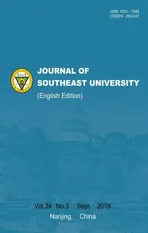Big data assessment on the operating characteristics of on-line taxis and thoughts on relevant policies
2018-10-17SunChaoChenXiaohongZhangMichaelChenShu
Sun Chao Chen Xiaohong Zhang H. Michael,3 Chen Shu
(1The Key Laboratory of Road and Traffic Engineering, Ministry of Education, Tongji University, Shanghai 201804, China)(2Shenzhen Urban Transport Planning Center Co., Ltd., Shenzhen 518021, China)(3Department of Civil and Environmental Engineering, University of California, Davis, CA 95616, USA)
Abstract:A double-dimensional big data assessment method on the characteristics of on-line taxi traffic operation is proposed to provide a scientific basis for carrying out the taxi industry reform and standardizing the on-line taxi hailing management work. Taking Shenzhen as an example, multi-source data such as on-line taxi license plate data, plate identification data and taxi (including on-line taxis) operation data are combined with the results of the stated preference (SP) survey on taxi operating characteristics to assess the overall operation characteristics of on-line taxis. The results show that the current on-line taxis in Shenzhen can be divided into three categories, that is, full-time on-line taxis, non-active on-line taxis and part-time on-line taxis, accounting for 4%, 55%, and 41%, respectively, of the total quantity. In terms of the characteristics of space-time operations, full-time on-line taxis have similar operating characteristics as those of traditional taxis; the operation of non-active on-line taxis and part-time on-line taxis coincides with commuting requirements during morning and evening peak hours. However, part-time on-line taxis operate for a much longer time period at night. Due to the convenient hailing and favorable price, on-line taxis have a significant impact on trip modes of citizens; and the substitution effect of on-line taxis on traditional buses and cruising taxis is obvious. It is beneficial for helping the government departments to objectively understand the development law of the on-line taxi industry and providing decision reference for the formulation of relevant management policies during the critical development stage of on-line taxi industry.
Keywords:on-line taxi; trip characteristics; license plate identification; stated preference(SP) survey; big data analysis; policy assessment
With the rapid development of mobile Internet technology, various on-line taxi (an abbreviation of the Internet booking taxi) hailing services, such as Didi, Kuaidi, Uber and Ola Cabs, have become popularized in recent years all over the world. The development of on-line taxi hailing services in China has roughly undergone three phases[1]. In the first phase (2013—2014, Internet+taxis), continuous market promotion was carried out by various platforms through such means as large-scale subsidies to reveal the habits of passengers who hail taxis with a smart phone APP. The second phase is the differentiated development phase beginning from the latter half of the year 2014. In this phase, various Internet platforms launched “tailored taxi” (an Internet booking taxi that provides quality services to high-end business travelers) service which is better than traditional cruising taxis but comes with a higher price. The third phase is the explosive growth development phase. In May 2015, a fast ride hailing service was launched and the threshold for non-operating vehicles (non-professional driver, vehicles without qualification of operation) such as private cars to be affiliated to various platforms was lowered significantly. The growth of on-line taxi hailing services was explosive in this phase. By the end of the year 2016, the order quantity of main platforms for on-line taxi hailing services in Shenzhen was 20 times that of 2015.
The on-line taxi is a new trip mode emerging on the basis of the integration of networked information transmission and application in the mobile Internet era and traditional transportation passenger service. Since private cars are introduced into operation, the operation of on-line taxis has raised extensive discussion and the focus of the discussion includes mainly: orientation and management of on-line taxis[1-6], scale management and control[5], legal framework[5], traditional industry reform[5-6], the interest game of participants[4-5], and regulatory rules[7]. In July 2016, the national government issued documents such as Guidelines on Promoting the Sound Development of the Taxi Service Industry, Interim Measures for the Administration of On-Line Taxi Booking Business Operations and Services, and the Decision of the Ministry of Transport on Amending the Provisions on the Administration of Taxi Operating Services to guide the taxi industry reform and the standardized management of on-line taxi hailing. In October 2016, local governments in China issued local management rules for on-line taxi hailing, which raised heated discussion in all sectors of the community[7].
At present, the discussion and studies on on-line taxis at home and abroad are mainly based on qualitative analysis. Only a few research achievements are made on the basis of quantitative analysis. He et al.[8]proposed the taxi service equilibrium model based on taxi hailing with smart phone to balance the supply-demand relationship of taxis. Qian et al.[9]put forward the taxi market equilibrium model based on the third-party taxi hailing service. According to this model, it is found that the size of taxi fleet and the pricing policies are closely related to the level of market competition, which may impose significant influence on the total cost and average waiting time of passengers as well as the utilization of the fleet. Wang et al.[10]proposed a service equilibrium model and pricing strategy based on the on-line taxi hailing platform. Gao et al.[11]studied the influence of on-line taxi development on the residents’ trip mode selection and traffic operation according to the questionnaire survey for on-line taxi users in Beijing as well as the tracking and monitoring on the road and traffic operation in Beijing. The results of the study show that the shifting rate from public transport and bicycle traffic to on-line taxi has reached up to 58%, which exacerbates traffic jams to a certain extent as well[11]. Since the operation data of the on-line taxi platform is not open, it is difficult to master the data about the operating conditions of the on-line taxis and the characteristics of passenger use and to conduct the pre-assessment of policy implementation effect; therefore, there are certain risks in policy formulation[12-13]. In this paper, Shenzhen is taken as an example and the double-dimensional analyzing method combining license plate identification data analysis with the SP survey is adopted to make quantitative analysis on the operating conditions of on-line taxis and the characteristics of passenger trip mode from two dimensions—macro operation and micro intention. The purpose is to assess the influence of the policies, provide decision-making supports for policy formulation, and put forward relevant thoughts according to the data analysis.
1 Related Work
The analysis in this paper is conducted from two dimensions: the overall operation of on-line taxis and the micro intention of the citizens to hail on-line taxis. As for the overall operation of on-line taxis, the composition, the use intensity and the space-time distribution of the current on-line taxis will be deeply analyzed through the clustering analysis on the characteristics of taxi use based on the matching of on-line taxi license plates and plate identification data. As for the on-line taxi hailing by the citizens, the intention of the citizens to hail on-line taxis and corresponding characteristics will be studied through the SP survey to analyze the substitution effect of on-line taxis on traditional trip modes and relevant problems. At the same time, the operation data of traditional taxis, buses and metros will be referenced to verify the above analysis and form a relatively complete evidence chain. Fig.1 illustrates the technology roadmap of the research.

Fig.1 Technology roadmap
2 Method
2.1 Macro operation analysis
2.1.1 Data description
The license plate identification data of working days in April 2016 in Shenzhen is used as the basis for the analysis in this paper. The main contents of the data includes: license plate numbers, ID of the monitoring points, lane numbers, passing time, and license plate type; and the main trunk roads of the whole city are covered by about 560 detecting sections of the license plate identification system. Data involving personal privacy, such as license information, is masked. The data about license plates of on-line taxis covers 4 main on-line taxi platforms in Shenzhen; and the content of the data mainly includes the license plates and the information about the affiliated platform. The data about license plates is also masked as the data about license plate identification, and about 30% vehicles with multiple registrations on two or more platforms are excluded.
2.1.2 Data matching and cleaning
Since the license identification system is influenced by the weather, equipment failure and system error, the plate identification data obtained after matching may have obvious errors such as maximum value. The wrong data will influence the subsequent modeling analysis and the description on operation characteristics of on-line taxis. In this paper, the standard deviation and the mean value of the number of being detected within each hour of the vehicle will be taken as the indicators for reflecting the degree of data variation and the data out of the interquartile range will be excluded as abnormal data[14].
2.1.3 Clustering analysis on on-line taxis
Considering the completeness, the concentration ratio and the strong correlation with other variables (even the cause-and-effect relationship), four variables including the daily average number of being identified by the license plate identification systemND, the proportion of the number of being identified during peak hours to the daily total number of being identifiedHH, the proportion of the number of being identified at night (20:00—24:00) to the daily total number of being identifiedHN, and the standard deviation of the number of being detected during 24 hS24are selected as the characteristic indices for clustering in this paper.
2.1.4 Operating characteristics of on-line taxis
The clustering analysis aims not only to master the quantity of various vehicles but also to collect the characteristics of vehicle moving and understand the common characteristics in use intensity and space-time distribution of each category of vehicles. On this basis, the operating characteristics of on-line taxis will be compared with those of traditional cruising taxis and private cars to provide further description on the properties of full-time, part-time and non-active vehicles of different clustering categories.
2.2 Micro individual trip intention analysis
2.2.1 Survey method
Representative commercial and residential communities are selected for the survey, including Luohu, Futian, Nanshan, Yantian, Baoan, Longhua, and Buji in Shenzhen. The respondents include office workers, community residents and citizens going out for recreation. An inquiring survey is adopted. 2 000 questionnaires are distributed and 1 912 effective questionnaires are finally obtained.
2.2.2 Survey contents
Three main contents are included: The first is the basic information about the citizens, including the gender, income and car ownership; the second is the taxi hailing habits, including the waiting time, hailing method, taxi type, and trip purpose; and the third is the intention of the citizens to hail taxis, including the substitution effect of on-line taxis on other trip modes as well as the existing problems and advantages of on-line taxis.
3 Results
3.1 Operating characteristics assessment
3.1.1 Categories of vehicles
According to the clustering analysis of k-means, the current on-line taxis in Shenzhen can be divided into three categories, accounting for 4%, 55%, and 41% of the total quantity, respectively. Since the daily average number of being identified by the license identification systemNDfor the vehicles of Clustering 1 is significantly higher than that of the other two categories. The vehicles of Clustering 1 are defined as full-time on-line taxis, that is, on-line taxis with full-time operation. The daily average number of being detected for vehicles of Clustering 2 is obviously lower than that of Clustering 3 and the activity intensity during 20:00—24:00 at night for vehicles of Clustering 2 is also obviously lower than that of Clustering 3. Therefore, the vehicles of Clustering 2 are defined as non-active on-line taxis in this paper, that is, vehicles picking up passengers only on the way to the company/on the way home or vehicles only registered on the platform but seldom engaged in operation. The vehicles of Clustering 3 are defined as part-time on-line taxis, that is, vehicles engaged in operation during spare time after work. Tab.1 shows the clustering results.

Tab.1 Statistics of clustering results
It can be seen from the clustering results that: After theon-line taxi hailing service represented by “fast ride” entered the market in 2015, the operation mode with low barrier to entry and high subsidies attracted a large number of private cars to enter the taxi industry. However, most of the private cars are part-time taxis or non-active taxis. The proportion of the full-time on-line taxis to the total number of the on-line taxis is relatively low in Shenzhen, but the absolute quantity of these taxis has already been close to the quantity of traditional taxis in Shenzhen.
3.1.2 Time distribution of vehicle operation
Ten thousand of red cruising taxis (a kind of cruising taxis that can carry passengers anywhere in Shenzhen and hereinafter referred to as red taxi) in Shenzhen are randomly selected for license identification and matching analysis. According to the comparison with vehicles of Clustering 1, the “down time” of traditional cruising taxis is not as obvious as that of on-line taxis due to the double-shift operation of traditional cruising taxis. In addition, the operation intensity of traditional taxis before and after 19:00 is relatively low because of being influenced by shift-change and evening peak. The vehicles of Clustering 1 have similar characteristics as those of traditional taxis. The first “down time” of these vehicles will appear at about 04:00—05:00. The main reason is that most on-line taxis are single-shift operation and will not participate in operations during midnight. The second “down time” of these vehicles will appear at 13:00—14:00. The main reason is that some vehicles may stop the service to have a noon break. Fig.2 shows a comparison of the distribution of the number of being detected during 24 h between red taxis and vehicles of Clustering 1 in Shenzhen.

Fig.2 Comparison of the distribution of the number of being detected during 24 h between red taxis and vehicles of Clustering 1 in Shenzhen
The peak hours for the operation of vehicles of Clustering 2 and Clustering 3 are overlapped with the morning and evening peak hours of the overall traffic operation, appearing at about 08:00 and 18:00. On one hand, most owners of non-active and part-time on-line taxis have commuting requirements; on the other hand, for a large number of part-time vehicles, passenger picking-up during morning and evening peak hours has become a normal state and beyond the scope of “sharing traffic”, and these vehicles have become taxis during the peak hours. However, the evening peak hours for vehicles of Clustering 3 will last to about 23:00 at night, which is different from those of the vehicles of Clustering 2. This indicates that some private car owners are engaged in on-line taxi operation during their spare time after work. Fig.3 shows a comparison of the operation time during 24 h between vehicles of Clustering 2 and Clustering 3.
3.1.3 Operating characteristics of vehicles
According to the investigation on the currenton-line taxis market in Shenzhen conducted by the author and the statistical analysis in this research on relevant operating indices of vehicles from different platforms, it can be seen that the main on-line taxi hailing platforms in the market have two operation modes. One type of platforms takes tailored taxi service as the main operation mode, providing high-quality service of “high-end vehicles+professional drivers”. UCAR adopts this operation mode. More than 64% of vehicles from this platform are vehicles of Clustering 1 (full-time on-line taxis); the daily average number of being detected for vehicles from this platform is 24.7, which is basically consistent with the daily average number (26.89) being detected for vehicles of Clustering 1 (full-time on-line taxis).
For some minutes he was too stunned12 by the treachery of his friend to think about anything at all, but after a while he shook himself awake, and determined13 that he would manage to keep alive somehow, if it were only to revenge himself

Fig.3 Comparison of the operation time during 24 h between vehicles of Clustering 2 and Clustering 3
The other type of platforms takes the fast ride hailing service as the main operation mode. Since the entry threshold is low, a large number of social vehicles are attracted to affiliation with these platforms, but most of these vehicles will not provide full-time on-line taxi service. Platforms such as Yongche, Didi and Uber adopt this operation mode. More than 90% vehicles from these platforms are vehicles of Clustering 2 (non-active vehicles) and Clustering 3 (part-time vehicles). The daily average number of being detected for vehicles from these platforms is less than 10; the daily average number of being detected for vehicles from Platforms Didi and Uber is the least, being 3.6 and 5, respectively.
3.2 Influence on trip mode structure
3.2.1 The influence of taxi hailing habit
According to this survey, the taxi-hailing applications such as Didi and Uber have gradually changed the taxi-hailing habit of citizens. Taxi-hailing with APP has taken the place of road side waving and become the most common taxi-hailing method. In this survey, about 70% respondents have the experience of taxi-hailing with APP. As for the types of on-line taxis chosen by citizens, fast ride possesses superior advantages, accounting for 66%; the tailored taxis account for 21%; and the ride sharing accounts for only 13%.
3.2.2 Advantages of on-line taxis
Easy calling, discount price and easy payment are the main reasons for choosing on-line taxis by passengers, accounting for 73%, 69% and 46%, respectively. On the one hand, the Internet platforms have obtained the price advantage compared with the traditional cruising taxis through repeated rounds of price subsidy, have supplemented the capacity of taxi market, and alleviated the problem of “difficult taxi-hailing”. On the other hand, since the riding environment is more comfortable than that of traditional buses, on-line taxis have attracted a large number of passengers. Tab.2 shows the reason for choosing on-line taxis by passengers.
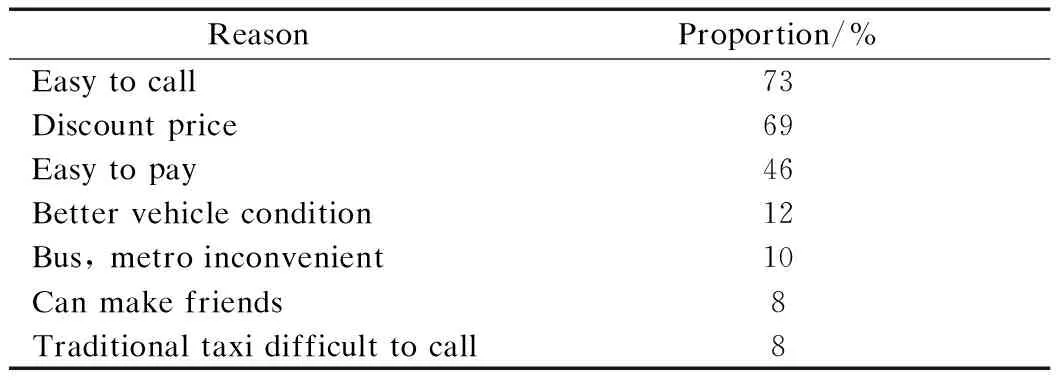
Tab.2 Reason for choosing on-line taxis by passengers
3.2.3 Substitution effect of on-line taxis
The survey result shows that most passengers without cars believe that on-line taxis have taken the place of traditional buses and taxis to a large extent. About 88% respondents without cars think that on-line taxis have taken the place of their public transport modes (this is a multiple-choice question (the same below)). Tab.3 shows substitution of on-line taxis for trip modes of respondents without cars. For respondents with cars, they also think that the traffic diversion effect of on-line taxis on buses and taxis is obvious but the substitution effect on private cars is limited. About 50% respondents with cars think that on-line taxis have taken the place of their public transport modes. Tab.4 shows substitution of on-line taxis for trip modes of respondents with cars.
Tab.3Substitution of on-line taxis for trip modes of respondents without cars
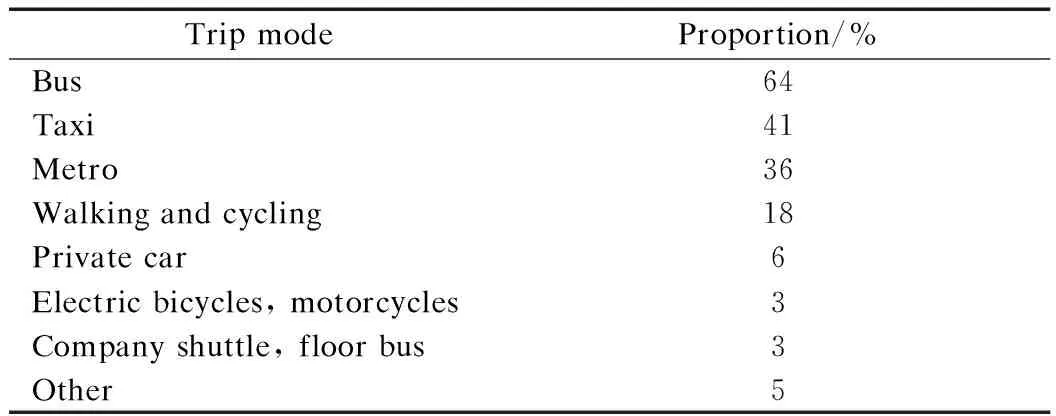
Trip modeProportion/%Bus64Taxi41Metro36Walking and cycling18Private car6Electric bicycles, motorcycles3Company shuttle, floor bus3Other5
Tab.4Substitution of on-line taxis for trip modes of respondents with cars
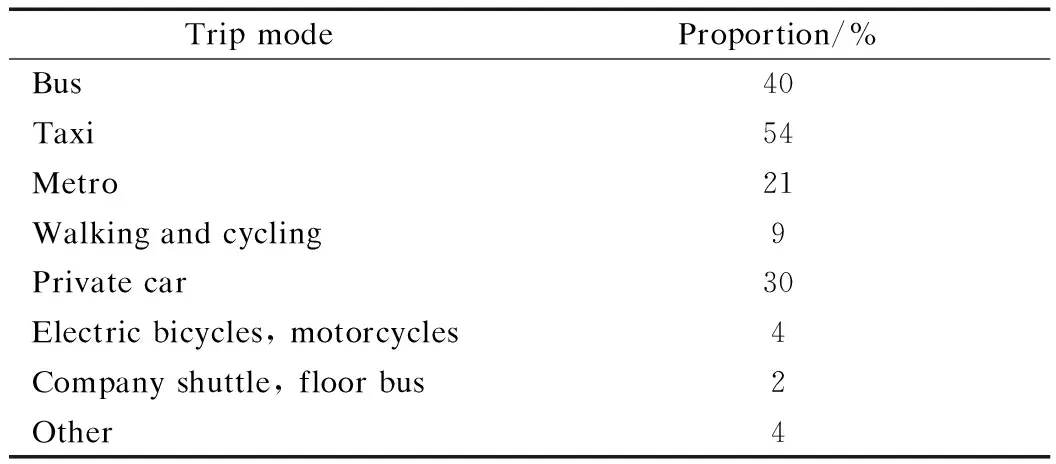
Trip modeProportion/%Bus40Taxi54Metro21Walking and cycling9Private car30Electric bicycles, motorcycles4Company shuttle, floor bus2Other4
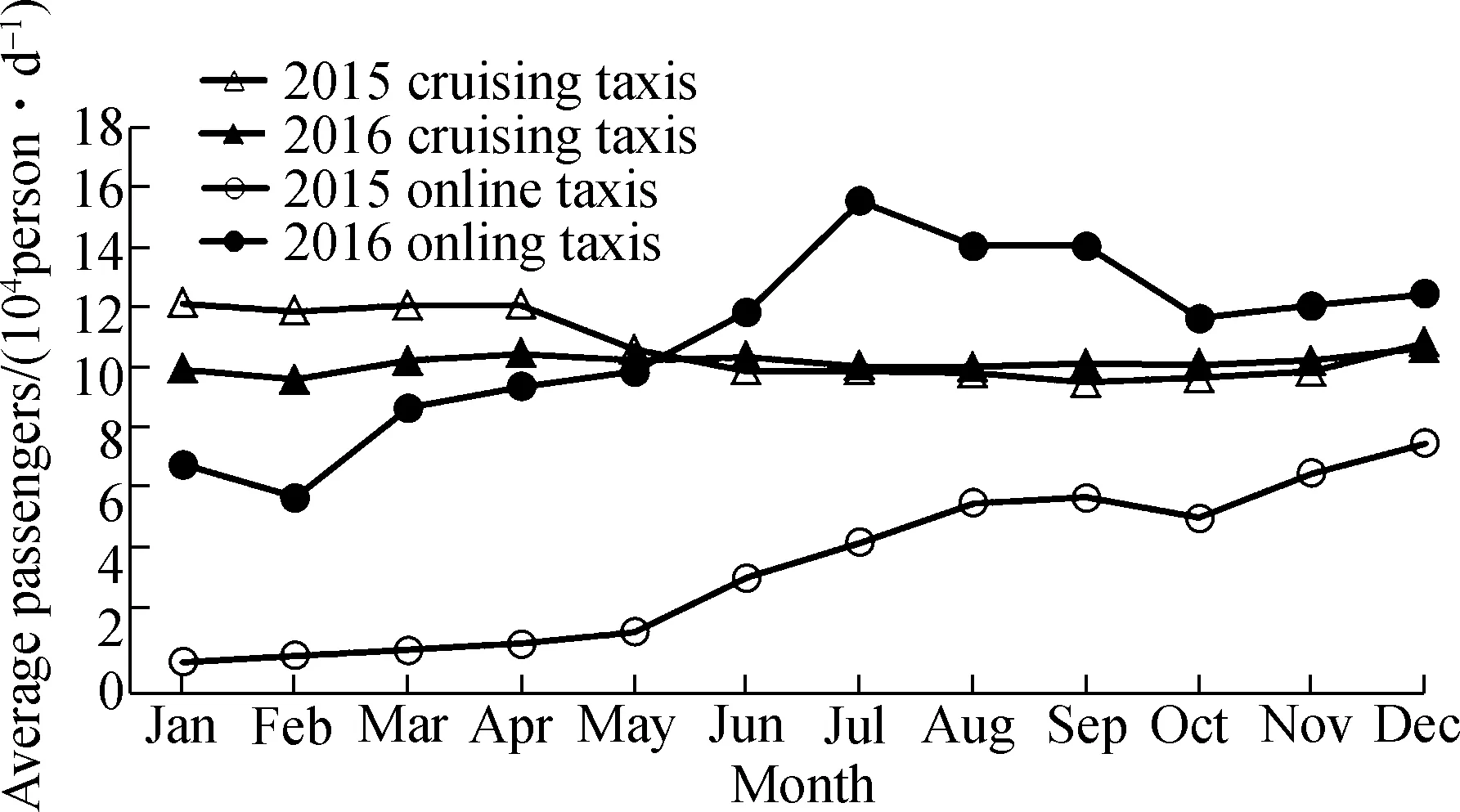
Fig.4 Daily average passenger volume change for cruising taxis and on-line taxis in 2015 and 2016
The passenger volume of traditional buses in 2016 is significantly lower than that of the corresponding period in 2015; the daily average passenger volume of traditional buses in the whole city is 5.6×105person/d lower than that in 2015. The passenger volume of rail transit in 2016 is significantly higher than that of the corresponding period in 2015; the daily average passenger volume of rail transit in the whole city is 4.7×105person/d higher than that in 2015. Fig.5 shows a comparison of passenger volume between traditional buses and rail transit in 2015 and 2016.

Fig.5 Comparison of passenger volume between traditional buses and rail transit in 2015 and 2016
3.2.4 Distribution of on-line taxis trip purpose
It can be seen from this survey that the proportion of passengers hailing on-line taxis for leisure and entertainment is the highest, accounting for 38%. In addition, the proportion of passengers hailing on-line taxis to commute to work/school is also high, accounting for about 27%. Moreover, relevant network research reports[15-16]also reveal that the peak hours for using tailored taxi service (fast ride) applications include 07:00—09:00 and 17:00—19:00, which are consistent with the time periods for commuting. Also, the number of users using tailored taxi service (fast ride) applications after work is more than that of daytime, which indicates that overuse of on-line taxis exists when commuting to work and school. Fig.6 shows the distribution of trip purposes of on-line taxi passengers.
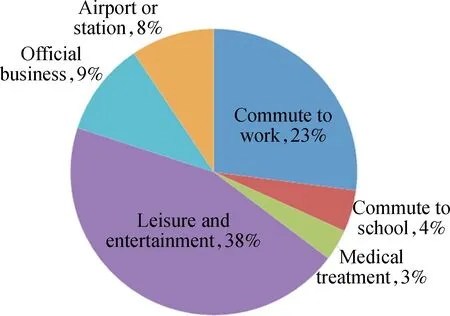
Fig.6 Distribution of trip purposes of on-line taxi passengers
3.2.5 Existing problems of on-line taxis
In addition to the support of capital strength, another important reason for the rapid occupation of the market by “fast ride” depending on its low price is that the platform evades the management cost which shall be borne by itself and problems such as improper registration audit of vehicles and drivers, and no basic operation insurance and lack of basic labor security for drivers are noticeable. According to the investigation on the problems of on-line taxis, “Drivers do not recognize the road” is the most prominent problem and 69% respondents select this problem. 86% respondents think that the platform management has many defects, such as disclosure of personal information, ambiguous accident responsibilities, unguaranteed security, bad background of the driver, and unsafe mobile payment. Tab.5 shows the existing problems of on-line taxis.
4 Thoughts on On-Line Taxis Policies
4.1 Market environment creation
The government should create the market environment for fair competition, encourage the enterprises to improve their service quality, and enhance the innovation capability of the enterprises through the healthy competition among multiple industry conditions of the taxi industry. On the one hand, full-time on-line taxis engaged in the operation activities along with traditional cruising taxis shall meet the requirements for the management of operating vehicles, such as the requirements for the recording of information about drivers and vehicles, the purchasing of operation insurance, and vehicle scrapping. The operating requirements can be optimized and adjusted to some extent based on the characteristics of the actual operation of on-line taxis, but the basic principle for fair competition must be followed. On the other hand, for those unfair competition activities such as dumping with lowered price and monopolized operation, the government shall adhere to its duty, carry out serious investigation, and maintain the market order.
4.2 Improvement of regulatory legislation
At present, the regulation paths adopted by different countries are also different: Recording management based on registration is adopted in Singapore; new traffic network company is established in the US for supervision and management; in the UK,on-line taxis are not categorized as common taxis according to relevant judicial determination but incorporated into the regulation system of private car rental; some other European countries represented by France take strict measures for restricting the operation of on-line taxis considering the pressure faced by workers of traditional taxi industry, or even prohibit the operation of on-line taxis[7].
It is suggested that the government shall improve the management methods for on-line taxis and issue regulations on the basic requirements for the operators, vehicles and drivers of on-line taxis, operation service specifications, supervision and inspection requirements, and relevant legal liabilities. The government shall perform duties according to laws, strengthen the supervision and management of safety operation of on-line taxis, and hold the bottom lines for the management. At the same time, the operators of the on-line taxi platforms shall adhere to their responsibilities, strengthen the management of vehicles and drivers, and protect the legal interest of the passengers. The management regulations for on-line taxis shall be issued as soon as possible to regulate the operation activities, which will be helpful for the explicitation of payable cost of on-line taxis and the recovery of the real price as well as the prevention of potential management risks.
4.3 Orderly promotion of industry development
The operation conditions, use characteristics and the influence of its development on traffic conditions of theon-line taxi shall be assessed properly through quantitative analysis. The population of Shenzhen under actual management is more than 20 million, but the average number of traditional cruising taxis for every ten thousand people is only one half of the national standard value. The quantity of full-time on-line taxis is basically equivalent to that of traditional cruising taxis and the operating characteristics of the two are similar. In this case, the on-line taxi has effectively alleviated the problem of insufficient transport capacity of traditional taxis and its influence on the traffic conditions during peak hours is limited. The large-scale development of fast ride may induce the increase of car trip demands and increase the sharing ratio of individual automobiles when commuting to work. However, the fast ride may also deviate from the functional orientation for taxis and intensify traffic jams during peak hours. The operation service of fast ride shall be regulated to recover its property of “ride-sharing”.
It is an inevitable choice for Shenzhen, a megacity with ultra-high population density, to build high-level public transport system during its urban transport development. The “Transport White Paper” of Shenzhen puts forward clearly the basic passenger transport policy of “giving priority to the development of public transport and guiding the vehicle usage properly”. On one hand, the priority will be given to the development of public transport in such aspects as traffic priority rules and resource allocation; on the other hand, the individual automobile trip demands during peak hours and in key regions shall be regulated properly through suitable management measures to optimize the traffic mode structure. The regulation of taxis (including on-line taxis) shall be incorporated into the overall passenger transport management framework of the whole city. The relationship between the taxis (including on-line taxis) and other transport modes shall be coordinated to recover the functional orientation of taxis and promote orderly development of the industry.
4.4 Improvement of public transport service quality
Relevant research shows that, compared with that of traditional buses, the passenger volume of the metro receives relatively limited influence from the development of fast rides, which indicates that the traditional public transport service with “single-mode” and “low price and low quality” cannot meet the increasingly diversified trip demands of citizens. The public transport service system needs to be enriched so that it provides more public transport services with “high quality and favorable price”. The rail transit shall be further developed and the coverage of rail transit shall be increased to solve the problem of “the last kilometer” and form the trip mode dominated by “rail transit+walking and cycling”. The reform of public transport system shall be promoted to encourage the development of “Internet+public transport” in order to provide high-quality and personalized public transport services.
5 Conclusion
Under the circumstances that new local policies on on-line taxis need to be issued but corresponding data support is lacking, this paper combines the macro operating characteristics analysis based on license identification data with the individual micro intention analysis based on the SP survey in an innovative manner, providing technical support for the formulation of policies on on-line taxis and obtaining pre-assessment on the implementation effect of the management policies. According to the research, although a large number of private cars are attracted by the low entry threshold of “fast ride” and registered as on-line taxis, the cars engaged in full-time operation are less than 5%; and most private cars only provide operation service during peak hours and nighttime. As for utilization, the booming development of on-line taxis has changed the trip mode of citizens. With the launching of the “fast ride” in the year 2015, the passenger volume of traditional cruising taxis and buses during the corresponding period was decreased significantly and overuse of on-line taxis also exists when commuting to work and school. During the formulation of local policies on on-line taxis, the government will be faced with more unpredictable difficulties and uncertainty, such as the relationship between public transport and on-line taxis, new industry conditions and old industry conditions, and the government and the market must be coordinated as a whole. It is suggested that the exploration of the implementation approach for taxi industry reform shall be strengthened in the next stage.
杂志排行
Journal of Southeast University(English Edition)的其它文章
- A recognition model of survival situations for survivable systems
- Stability analysis of lead-vehicle control model in cooperative adaptive cruise control platoon within heterogeneous traffic flow
- Experimental study of the onset of nucleate boiling in vertical helically-coiled tubes
- Syntheses and calculation of (E)-4-chloro-4’-ethoxystilbene and (E)-4,4’-dichlorostilbene
- A weighted selection combining schemefor cooperative spectrum prediction in cognitive radio networks
- Damage evolution analysis of cast steel GS-20Mn5V based on modified GTN model
